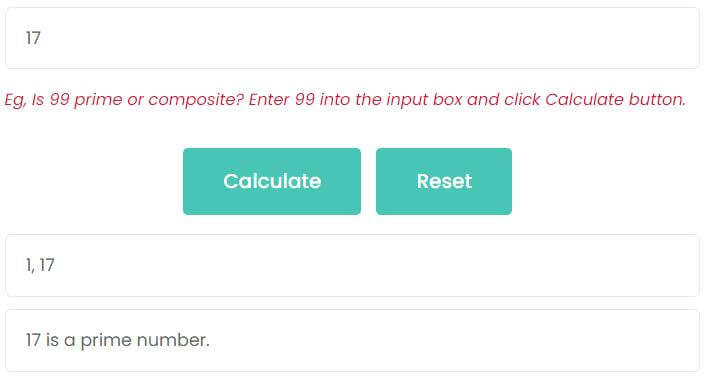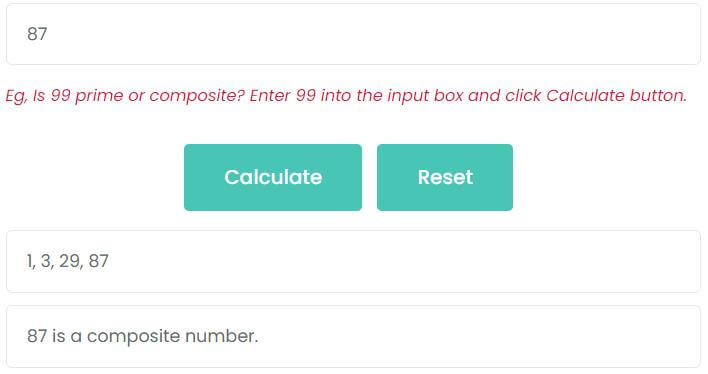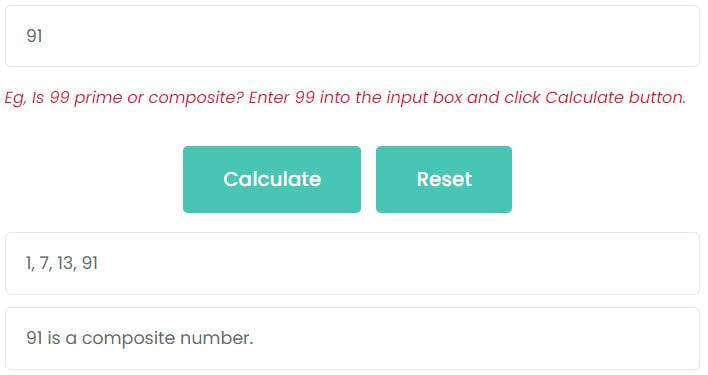Welcome to use the Prime and Composite Number Checker, which can quickly help you verify whether the number is prime or composite.
Definition of prime and composite numbers
A prime number is a natural number that has no factors other than 1 and itself among the natural numbers greater than 1. For example, both 3 and 7 are prime numbers with no factors other than 1 and themselves.
The opposite of a prime number is called a composite number, that is, an integer greater than 1, which is divisible by other numbers besides 1 and itself. For example, 4 and 10 are composite numbers.
Note that prime and composite numbers apply to integers greater than 1, so 1 is neither prime nor composite.
When judging whether a number is prime or composite, the key is to count the number of its factors. If there are only two factors, in other words, only 1 and itself, then the number is prime. If the number of factors is greater than 2, then the number is composite.
First 100 Prime Numbers
| 2 | 3 | 5 | 7 | 11 | 13 | 17 | 19 | 23 | 29 |
| 31 | 37 | 41 | 43 | 47 | 53 | 59 | 61 | 67 | 71 |
| 73 | 79 | 83 | 89 | 97 | 101 | 103 | 107 | 109 | 113 |
| 127 | 131 | 137 | 139 | 149 | 151 | 157 | 163 | 167 | 173 |
| 179 | 181 | 191 | 193 | 197 | 199 | 211 | 223 | 227 | 229 |
| 233 | 239 | 241 | 251 | 257 | 263 | 269 | 271 | 277 | 281 |
| 283 | 293 | 307 | 311 | 313 | 317 | 331 | 337 | 347 | 349 |
| 353 | 359 | 367 | 373 | 379 | 383 | 389 | 397 | 401 | 409 |
| 419 | 421 | 431 | 433 | 439 | 443 | 449 | 457 | 461 | 463 |
| 467 | 479 | 487 | 491 | 499 | 503 | 509 | 521 | 523 | 541 |
First 100 Composite Numbers
| 4 | 6 | 8 | 9 | 10 | 12 | 14 | 15 | 16 | 18 |
| 20 | 21 | 22 | 24 | 25 | 26 | 27 | 28 | 30 | 32 |
| 33 | 34 | 35 | 36 | 38 | 39 | 40 | 42 | 44 | 45 |
| 46 | 48 | 49 | 50 | 51 | 52 | 54 | 55 | 56 | 57 |
| 58 | 60 | 62 | 63 | 64 | 65 | 66 | 68 | 69 | 70 |
| 72 | 74 | 75 | 76 | 77 | 78 | 80 | 81 | 82 | 84 |
| 85 | 86 | 87 | 88 | 90 | 91 | 92 | 93 | 94 | 95 |
| 96 | 98 | 99 | 100 | 102 | 104 | 105 | 106 | 108 | 110 |
| 111 | 112 | 114 | 115 | 116 | 117 | 118 | 119 | 120 | 121 |
| 122 | 123 | 124 | 125 | 126 | 128 | 129 | 130 | 132 | 133 |
How to use the prime and composite number checker
The procedure to use the prime and composite number checker is as follows:
- Enter the positive integer.
- Click Calculate button to check whether the input integer is prime or composite.
- Click the Reset button to start a new check.
Solved examples using the prime and composite number checker
Example 1: Is 17 prime or composite?
Enter 17 into the input box and click Calculate button, as shown in the figure, the factors of 17 are 1 and 17. So, 17 is a prime number.

Example 2: Is 87 prime or composite?
Enter 87 into the input box and click Calculate button, as shown in the figure, the factors of 87 are 1, 3, 29 and 87. So, 87 is a composite number.

Example 3: Is 91 prime or composite?
Enter 91 into the input box and click Calculate button, as shown in the figure, the factors of 91 are 1, 7, 13 and 91. So, 91 is a composite number.

Latest calculators
Standard Form to Slope-Intercept Form Calculator
Slope Intercept Form Calculator
Slope Calculator: Calculate Slope, X-Intercept, Y-Intercept
Reciprocal of Complex Number Calculator
Conjugate Complex Number Calculator
Modulus of Complex Number Calculator
Profit Percentage Calculator: Calculate Your Profitability Easily
Attendance and Absence Percentage Calculator
Circular Segment Radius Calculator
Regular Polygon Side Length Calculator
Annulus Calculator for Width, Perimeter, and Area